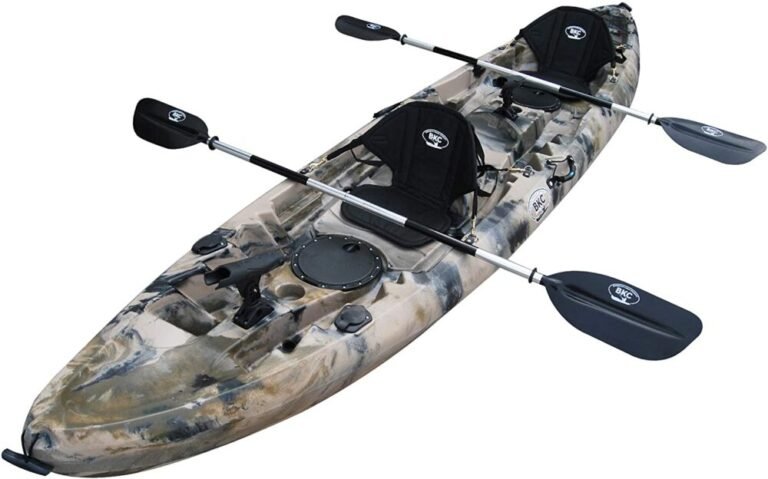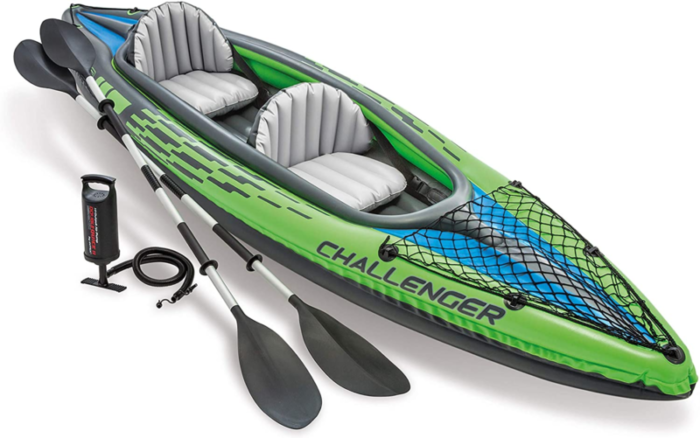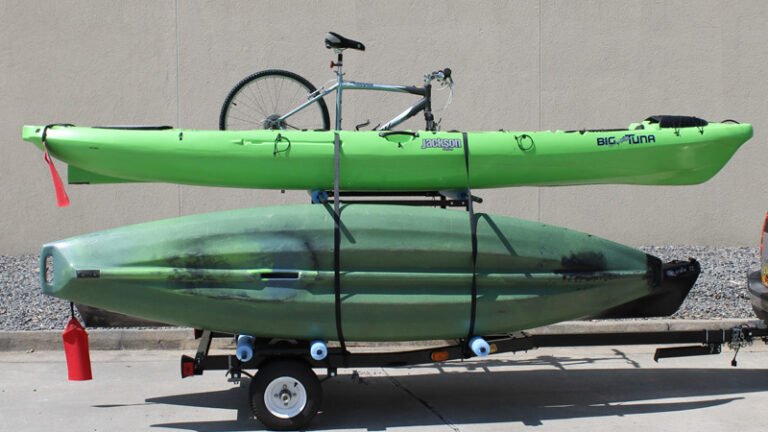Kayak Materials Explained: What Are Kayaks Made Of?

Kayaking is a great way to explore the waterways near your home. It’s also a great way to get exercise since you’ll be working up a sweat while paddling. Kayaks are versatile and can be used for a variety of different purposes, including fishing, swimming, and touring.
There are a few different types of kayaks available on the market, each with its own unique features. Depending on the manufacturer, kayaks can be made from a variety of materials, including fiberglass, plastic, and PVC.
This variety is useful for two reasons: first, it allows different kayakers to find the right kayak for their individual needs; kayakers choose their kayaks based on their budgets, personal taste, storage space, and other available resources.
Secondly, it ensures that each kayak is resistant to certain types of damage and has individual qualities that make them unique. Each material has its own unique strengths and weaknesses.
For example, plastic kayaks are often less expensive and lighter, but they can be damaged easily when compared to other materials.
Knowing the materials kayaks are made from helps you better understand the watercraft and always comes in handy when you want to get a kayak of your own. The materials kayaks are made from and their pros and cons are discussed in this article.
How To Decide What Your Kayak Should Be Made Of
Anyone can buy a kayak, but choosing the right one for your needs and budget can be tricky. To help you make that choice, there are certain questions you have to answer. Properly answering these questions makes it easy for you to pick an appropriate kayak.
What Type Of Water Do You Plan On Using The Kayak In?
Kayaks are traditionally made of different materials depending on the type of water they will be used in. For instance, kayaks designed for whitewater use are typically made of more durable materials than those designed for flatwater use.
Additionally, kayaks designed for offshore fishing typically have a heavier bottom and are built to stay dry in choppy water. So, when deciding what type of kayak to purchase, it is important to consider the specific water conditions that you will be using it in.
To make the best decision for your safety, you should research which type of water your area is known to have and choose a kayak made from a material that is resistant to that particular type of water.
How Heavy Will The Kayak Be?
Kayaks come in a variety of weights, from very light to very heavy; some kayaks can weigh as little as 10 pounds, while others can weigh up to 50 pounds. The weight of a kayak is one factor you should consider when choosing a kayak material.
This is because the material the kayak is made of directly influences how heavy the watercraft will be. Why should I concern myself with the weight of a kayak? you might ask.
But when you are alone and have to transport the kayak or even perform a mundane task like lifting the kayak to your vehicle’s roof, will you be able to accomplish that on your own?
If you are sure you will have help whenever you have to move the kayak, then the weight might not bother you much; if not, get a kayak you can easily handle – it’s not worth it to own a kayak that will constantly frustrate you.
How Often Will You Be Using It?
When deciding what material your kayak should be made of, you should consider how often you will be using it.
If you intend to use the kayak regularly for fishing, for instance, you will want to procure a kayak that will not only be suitable for the task but will also be durable.
If you are a recreational kayaker who hits the water once in a while, you might not need a particularly durable kayak, as the watercraft will spend most of its time in storage.
You might even decide it pays you more to simply hire a kayak when you are ready for an adventure.
How Much Money Are You Willing To Spend?
If you’re on a budget, you may want to consider choosing a kayak made of plastic. These kayaks are typically less expensive than those made from other materials and are quite light as well.
However, if you’re looking for a durable kayak that will last for years, you’ll want to consider investing in a kayak made from stronger materials.
Ultimately, your kayak choice comes down to how much you are willing to spare to get the wonderful watercraft you desire.
Who Is Using It With You?
Kayakers often debate the merits of different materials when constructing their vessels. The most common arguments concern weight distribution, cost, and durability.
But which other factors should a kayaker consider when purchasing a kayak? Though not as obvious as other criteria, the number of people using a kayak will play a great role in how long it lasts.
Even with proper maintenance, a kayak used by multiple people will tire faster than the one you use on your own.
If the kayak will be used by different people, it would be a smart idea to buy a resilient and durable one to ensure you can enjoy the watercraft for years to come.
Types of Kayak Materials
Polyethylene
Polyethylene is a type of plastic that is most commonly used to make bags, containers, and other items. It is a linear polymer made from ethylene and one or more comonomers.
Polyethylene is resistant to heat, chemicals, and most other types of damage. Most plastic kayaks are made from polyethylene.
Polyethylene kayaks are versatile and affordable watercraft that are perfect for a variety of recreational activities. They’re lightweight, soft, and easy to store, making them ideal for taking with you on trips.
Polyethylene kayaks are also resistant to most chemicals and have a wide range of color options, so you can find the perfect one for your needs. Polyethylene is strong and does not puncture easily, making it ideal for canoeing and fishing trips.
These kayaks can also hold up to 500 pounds, so you can bring as much gear as you want. The downside to polyethylene kayaks is that they can be hard to repair if they break.
Pros
- Polyethylene kayaks are durable.
- They have a relatively low cost, which makes them affordable.
- Polyethylene kayaks are versatile and can be used for both fishing and recreational activities.
- They are resistant to most water conditions making them a good choice for beginners and experienced kayakers alike.
Cons
- Polyethylene kayaks can be damaged if not properly stored.
- They are heavy compared to some other materials used in kayaks.
Fiberglass
Fiberglass is a very strong and lightweight material that is made from a combination of glass and plastic. It is often used in boats, airplanes, and other objects that need to be light but durable.
Fiberglass is also good for making things like raincoats, car roofs, and bike frames because it is very flexible. Fiberglass is not as strong as metal, but it is much more flexible and lighter.
Fiberglass kayaks are quite popular because they offer a lot of advantages over traditional kayaks. They’re lighter and easier to transport, and they’re less expensive than wooden kayaks.
Fiberglass kayaks are also more affordable than composite material kayaks. A major weakness of these kayaks is the fact that they are brittle and do not do well with rough landings and impact on rocks.
This flaw is inherent to fiberglass itself, as the material is hard; generally, the harder a material is, the more brittle it is. People skilled in those areas can easily repair fiberglass kayaks, so you could potentially keep using them forever.
Pros
- They are lighter than polyethylene and wood kayaks.
- Fiberglass kayaks are more resilient to ultraviolet rays damage from the sun than polyethylene kayaks.
- Fiberglass kayaks are also less costly than carbon fiber and Kevlar kayaks.
Cons
- Fiberglass kayaks are costlier than polyethylene kayaks.
- They require high skill to repair so they may not be ideal for an average person.
- Chemicals are used in the repair of these kayaks and respirator protectors are required. These things make them a hassle to maintain.
- They are far more brittle than polyethylene kayaks and tend to fracture when they make an impact with rocks or are involved in rough landings.
Wood
Wooden kayaks are slowly disappearing these days. These kayaks are often very beautiful and have exquisite craftsmanship. Wooden kayaks can be made light but they can also be heavy, especially when made of hardwood.
They are generally heavier than plastic and fiberglass kayaks. Wood kayaks also tend to be quite expensive because of their craftsmanship.
Wooden kayaks have a natural feel that many people enjoy but they tend to be easily damaged on the water by rocks and other things.
Pros
- Wooden kayaks are made from natural materials, which means they are environmentally friendly. They don’t require any paints or coatings, which means they’re less harmful to the environment.
- Wooden kayaks are often more stable than their plastic or fiberglass counterparts and can be used in more challenging water conditions.
Cons
- They are quite expensive and thus not easily affordable.
- Wooden kayaks tend to be heavier than fiberglass and polyethylene kayaks.
- They are susceptible to damage from rocks and other things in the water.
Kevlar
Kevlar is a synthetic fiber made from carbon and hydrogen. It is one of the strongest fibers known to man and can resist a lot of force before it fails.
Kevlar has a high strength-to-weight ratio and good toughness, which makes it especially valuable for products that require protection from impact or fire. Kevlar is also resistant to most chemicals and heat.
Kevlar is often used in things like bulletproof vests, helmets, and ropes because of its strength and resistance to damage. Kevlar is also used in medical supplies and artificial skin.
Kevlar kayaks are a recent development in the world of kayaking and some of the safest kayaks on the market. They are becoming increasingly popular for a few reasons.
For one, they’re incredibly durable and can handle a lot of abuse. They’re also very comfortable to use, even for long periods. Kevlar is also a very lightweight material, so these kayaks are easy to transport.
Kevlar kayaks are perfect for those who want to explore remote areas or are worried about their equipment surviving a fall into the water.
Kevlar kayaks are very stable and easy to store because they do not take up a lot of space. They are also easy to care for making them an excellent choice for beginner paddlers.
Finally, kevlar kayaks are relatively affordable, making them an attractive option for many people.
Pros
- Kevlar kayaks are one of the lightest kayaks.
- They are less susceptible to ultraviolet damage.
- They are more resistant to wear and tear than most other kayaks.
- They are highly resistant to heat.
Cons
- Like fiberglass, they are more likely to fracture on impact with rocks or in collisions and their hardness makes them brittle.
- They are quite costly compared to other kayak types on the market.
- Like fiberglass, they require skill to repair and chemicals are used in the reparation.
Carbon Fiber
Carbon fiber is a material composed of interconnected carbon nanotubes. Carbon fiber is made from a long filament of carbon atoms that are tightly bound together.
The filament is then chopped into small pieces and heated until the carbon atoms melt and bond together. This creates an incredibly strong and flexible material.
It is strong, lightweight, and has a variety of useful properties, including being able to resist damage from high temperatures and chemicals.
Carbon fiber can be used in a wide range of applications, from aerospace to automotive to sporting goods. Carbon fiber is stronger than steel and almost twice as light.
Carbon fiber kayaks are the latest innovation in the world of water sports. They are not only stylish but also very sturdy and reliable.
The bodies of these kayaks are made of carbon fiber which makes them incredibly strong and lightweight. They are also very easy to maintain, requiring nothing more than a good wipe-down with a cloth every so often.
Carbon fiber kayaks are a good option for those who want to minimize their environmental impact. Some of the key benefits of carbon fiber kayaks include their strength, durability, and low emissions.
Pros
- They have the greatest strength-to-weight ratio of all kayaks.
- They are incredibly light.
- Carbon fiber kayaks are very resistant to heat.
- They are even less susceptible to ultraviolet damage than polyethylene and Kevlar kayaks.
- They have the greatest resistance to damage of all kayaks.
Cons
- Naturally, carbon fiber kayaks are some of the most expensive kayaks out there.
- They are more susceptible to fracture from impact loads than polyethylene kayaks.
- They require great skill and the use of chemicals to repair when damaged.
Inflatable Kayaks
Inflatable kayaks are a new and exciting option for those looking for more fun and adventurous ways to explore the lake or river near their home.
These kayaks are made from sturdy PVC and can be rented from many places, including sporting goods stores and even some airports.
They are also relatively easy to store when not in use, making them a great option for vacationers who don’t want to take up too much space in their rental car.
Pros
- They are easy to store and transport, making them a great choice for trips near or far.
- Inflatable kayaks are not subject to the same legal restrictions as hardshell kayaks, so they can be used in more places than traditional kayaks.
- They are a great choice for first-time kayakers, as they are relatively easy to use and provide good stability.
Cons
- They can be expensive.
- Inflatable kayaks may not provide the same level of stability or durability as traditional kayaks.
- Inflating them can be time-consuming.
Kayaks are made of a variety of materials depending on their purpose. Inflatable kayaks are made of sturdy PVC material while racing and whitewater kayaks are made of fiberglass or carbon fiber for strength and durability.
Kayaks can also be made of wood or aluminum, but these materials are not as common. Plastic kayaks are another famous kayak as they are quite lightweight and durable, making them the perfect option for beginners and experienced paddlers alike.
They are also probably the most affordable of all kayak types. No matter what material your kayak is made of, it is important to take care of it and store it properly to ensure its longevity.
Remember that each material has its own benefits and drawbacks, so it’s important to choose the right one for your needs. It is important to consider the material when purchasing a kayak because it will affect the weight, durability, and price of the kayak.






